
| KIT #: | 61120 |
| PRICE: | $80.00 SRP |
| DECALS: | Two options |
| REVIEWER: | Tom Cleaver |
| NOTES: |
2019 release |

| HISTORY |
The Lockheed P-38 Lightning was created in response to USAAC Circular Proposal 608, issued in February 1937. Authored by First Lieutenants Benjamin S. Kelsey and Gordon P. Saville, the proposal called for a twin-engine high-altitude "interceptor" having "the tactical mission of interception and attack of hostile aircraft at high altitude." In a 1977 interview, Kelsey recalled he and Saville used the word “interceptor” to bypass the inflexible Army Corps requirement that pursuit aircraft carry no more than 500 lb of armament, including ammunition, and that such an aircraft have no more than one engine. Kelsey was looking for an armament double the official restriction. The circular’s specifications called for a maximum airspeed of at least 360 mph at altitude and an ability to climb to 20,000 ft in six minutes, the most advanced set of specifications the USAAC had ever presented to that time.
Lockheed’s Hall Hibbard and Clarence "Kelly" Johnson considered a range of twin-engine configurations, including placing both engines in a central fuselage with push–pull propellers. Eventually they chose twin booms to accommodate the tail assembly, engines, and turbo-superchargers, with a central nacelle for the pilot and armament, a configuration which had been recently demonstrated by the Fokker G.1, which Johnson later confirmed was a strong influence on their design choice.
Lockheed won the competition on June 23, 1937 and was contracted to build a prototype XP-38 for $163,000, though Lockheed's costs would be $761,000. Construction began in July 1938 and the XP-38 first flew on January 27, 1939 with Ben Kelsey at the controls.
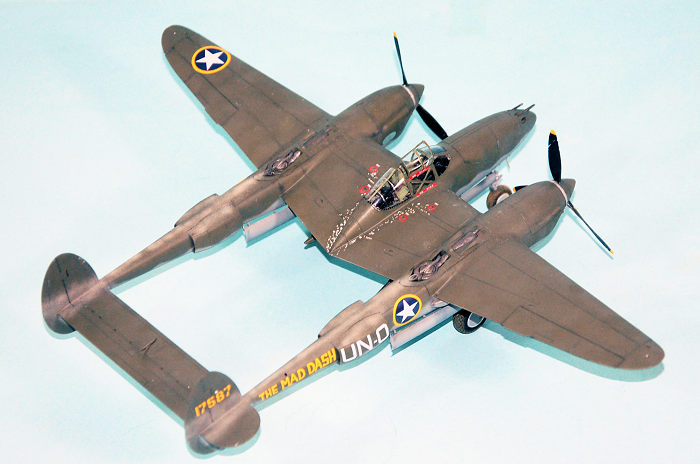 Kelsey proposed a speed dash to Wright Field on February 11, 1939 where
the aircraft would be further tested. "Hap" Arnold approved of the record
attempt and recommended a cross-country flight to New York. Kelsey set a record
flying from California to New York in 7 hours and 2 minutes, not counting two
refueling stops,but the XP-38 crashed due to carburetor icing short of the
Mitchell Field runway in Hempstead, New York, and was wrecked. On the basis of
the record flight, the Air Corps ordered 13 YP-38s on April 27, 1939. Tony
LeVier always said the record flight was an unnecessary stunt that set back
development of the p-38.
Kelsey proposed a speed dash to Wright Field on February 11, 1939 where
the aircraft would be further tested. "Hap" Arnold approved of the record
attempt and recommended a cross-country flight to New York. Kelsey set a record
flying from California to New York in 7 hours and 2 minutes, not counting two
refueling stops,but the XP-38 crashed due to carburetor icing short of the
Mitchell Field runway in Hempstead, New York, and was wrecked. On the basis of
the record flight, the Air Corps ordered 13 YP-38s on April 27, 1939. Tony
LeVier always said the record flight was an unnecessary stunt that set back
development of the p-38.
The XP-38 was designed to carry two .50-caliber M2 machine guns with 200 rpg, two .30-caliber weapons with 500 rpg, and a T1 Army Ordnance 23 mm cannon with a rotary magazine. In the YP-38s, a 37 mm M9 cannon with 15 rounds in three five-round clips was substituted for the T1. It proved unreliable in flight. Further armament experiments between March-June 1941 resulted in the P-38E configuration of four M2 Browning machine guns with 500 rounds per gun and one Hispano 20 mm cannon with 150 rounds. The nose-mounted guns meant that a Lightning could reliably hit targets at any range up to 1,000 yds. Rate of fire was about 650 rpm for the cannon and 850 rpm for each .50-caliber machine gun, giving a combined rate of fire over 4,000 rpm with every sixth projectile a 20 mm shell. Duration of fire for cannon was 14 seconds while the machine guns for 35 seconds. The 20mm cannon used with the P-38F onwards had a duration of fire of 45 seconds.
By the time of the Pearl Harbor attack that propelled the United States into active participation in the Second World War, the P-38 was the most modern USAAC fighter in the inventory. Until the introduction of the P-51 Mustang, it was the longest-range USAAF fighter, and became the most successful USAAF fighter in the Pacific Theater, where it was credited with shooting down more Japanese aircraft than any other USAAF fighter in the Pacific War.
The transformation of the P-38 from fast-climbing point-defense interceptor to long-range air superiority fighter didn’t happen overnight.
Production of the YP-38s fell behind schedule, due to the fact they had to be nearly completely redesigned to become suitable for mass production after the XP-38 was hand-built. Even with this, the P-38 would be the most difficult US fighter to produce, since at the time of the redesign Lockheed still only contemplated a production run of less than 100 airplanes. The YP-38s were substantially lighter than the prototype, with propeller rotation reversed so the blades spun outward, away from the cockpit, rather than inward as before. While this improved the aircraft's stability as a gunnery platform, it made loss of an engine on takeoff difficult since the rotation provided no support for the “dead” wing.
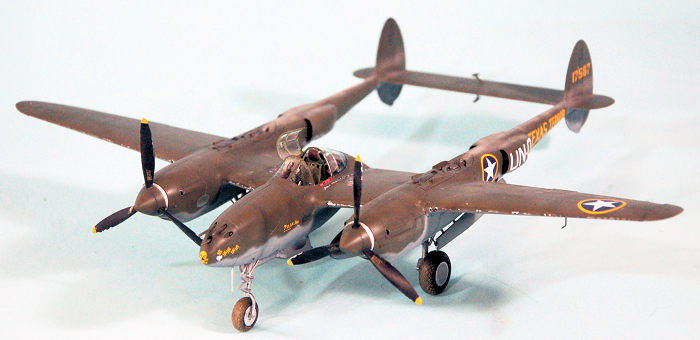 At the same time, the Lockheed factory in Burbank grew from a company
specializing in small orders to one of the largest defense contractors with the
adoption of the Model 14 Super Electra as the Hudson bomber by the RAF with a
major contract. Thus, the first YP-38 did not fly until September 17, 1940, with
the thirteenth and final YP-38 delivered in June 1941. By September 1941, 66
P-38s had been delivered, though none was combat-capable. Thirty of were
delivered in mid-1931 without armament, but after the armament tests in the
spring of 1941, they were subsequently fitted with what would be the standard
P-38 armament of four .50 caliber machine guns and a 37 mm cannon. They had
armored glass, cockpit armor and fluorescent cockpit controls. From European
combat reports, the remaining 36 were given self-sealing fuel tanks and enhanced
armor protection to make them combat-capable and were designated P-38D; outside
of a P-38A with a pressurized cockpit, there were no P-38Bs or Cs. The P-38Ds
were used to work out bugs and give the USAAF experience in handling the type.
At the same time, the Lockheed factory in Burbank grew from a company
specializing in small orders to one of the largest defense contractors with the
adoption of the Model 14 Super Electra as the Hudson bomber by the RAF with a
major contract. Thus, the first YP-38 did not fly until September 17, 1940, with
the thirteenth and final YP-38 delivered in June 1941. By September 1941, 66
P-38s had been delivered, though none was combat-capable. Thirty of were
delivered in mid-1931 without armament, but after the armament tests in the
spring of 1941, they were subsequently fitted with what would be the standard
P-38 armament of four .50 caliber machine guns and a 37 mm cannon. They had
armored glass, cockpit armor and fluorescent cockpit controls. From European
combat reports, the remaining 36 were given self-sealing fuel tanks and enhanced
armor protection to make them combat-capable and were designated P-38D; outside
of a P-38A with a pressurized cockpit, there were no P-38Bs or Cs. The P-38Ds
were used to work out bugs and give the USAAF experience in handling the type.
Until the problem was solved with adoption of dive flaps in 1944, the P-38 suffered from the phenomenon of “mach tuck” in a power dive. As dive speed approached Mach 0.68, the tail would begin to shake violently and the nose would tuck under, steepening the dive. Once caught in this, the fighter entered a high-speed compressibility stall. The controls would lock up, leaving the pilot no option but to bail out if possible or remain with the aircraft until it got down to denser air, where he might have a chance to pull out. Until the problem was solved, pilots became reluctant to fly their airplane to its maximum performance, as the loss rate in the first four fighter groups equipped with the P-38 approached one fatality a week. The first attempted solution was the use of spring-loaded servo tabs on the ailerons, which multiplied the force of the pilot’s pull-back on the control yoke. When Ralph Virden attempted to test this in YP-38 #1 on November 4, 1941, he completed the test sequence successfully, but 15 minutes later was seen in a steep dive followed by a high-G pullout. The tail unit of the aircraft failed at about 3,500 ft during the high-speed dive recovery and Virden was killed in the crash. The Air Corps suggested that flutter was the problem and directed Lockheed to install mass balances on the elevator; these had no effect on the problem, but were kept on the airplane by Air Corps directive. Buffeting was also a problem, but this was solved by the installation of a fillet between the central nacelle and the leading edge of the inner wing.
Ben Kelsey went against Air Corps policy against developing long range
fighters capable of escorting bombers when he urged Lockheed to add to the range
of the airplane with the P-38E developed in the summer of 1941. Lockheed
developed a drop tank with a laminar shape that did not adversely affect
performance, which carried 150 gallons (later 165 gallons), and the inner wing
between the nacelle and engines, where the fuel tanks were, was plumbed to carry
these tanks, which were pressurized and worked at high altitude. After Pearl
H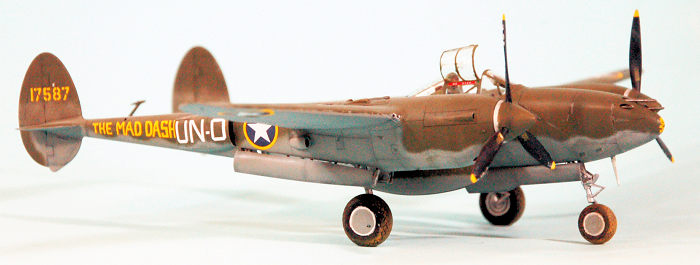 arbor, P-38Es were sent to a modification center in Dallas to have the tanks
fitted. The first P-38Fs also had to be modified after production, this time at
the factory. From the P-38G onward, the airplane came off the production line
fully fitted to use the drop tanks.
arbor, P-38Es were sent to a modification center in Dallas to have the tanks
fitted. The first P-38Fs also had to be modified after production, this time at
the factory. From the P-38G onward, the airplane came off the production line
fully fitted to use the drop tanks.
The P-38Es were the first “combat capable” P-38, and many were eventually sent to Alaska where they took part in the Aleutians campaign, while the even more combat-capable P-38F started coming off the production lines in May 1942. With the tanks, the P-38s were capable of flying the Atlantic with refueling stops in Newfoundland, Greenland and Iceland before arriving in Ireland. “Operation Bolero” saw the P-38Fs of the 1st Fighter Group sent to the UK by air.
By the summer of 1942, the 1st Fighter Group, the first unit equipped with the Lightning, had seen personnel taken as cadre to create first the 14th, then the 78th and finally the 82nd Fighter Groups. It was planned that these four groups would provide fighter escorts for the B-17s and B-24s of the growing 8th Air Force in England. With the new tanks, the P-38Fs were capable of flying the Atlantic with refueling stops in Newfoundland, Greenland and Iceland before arriving in Ireland. “Operation Bolero” saw the P-38Fs of the 1st Fighter Group sent to the UK by air. They were followed by those of the 14th FG, while the 82nd was sent by sea in October and the 78th in November. By then, the Air Force was fully involved in the invasion of North Africa, and the P-38s would see their first combat there.
“Happy Jack” Ilfrey:
Jack Ilfrey was one of the real “characters” of the USAAF in World War II. Born and raised in Houston, Texas, he left his studies at Texas A&M and joined the USAAC as an Aviation Cadet with his friend and fellow Aggie, John Landers. The two of them graduated from flight school on December 12, 1941, in a class that included George Preddy. While Landers and Preddy were assigned to the 49th Fighter Group and sent to the Pacific, Ilfrey received orders to the 1st Fighter Group.
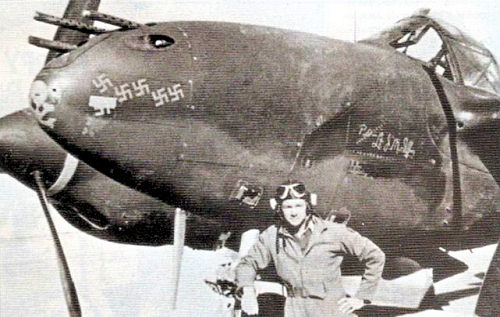 Ilfrey was in the initial formation that flew the Atlantic in Operation
Bolero. After training in England, they undertook four missions over France,
during which the group experienced its first combat loss on October 2, 1942,
when a P-38F escorting B-17s on a mission to Méaulte, France, was shot down by a
Fw-190 of JG 26 near Calais, killing 2nd Lt. William H. Young.
Ilfrey was in the initial formation that flew the Atlantic in Operation
Bolero. After training in England, they undertook four missions over France,
during which the group experienced its first combat loss on October 2, 1942,
when a P-38F escorting B-17s on a mission to Méaulte, France, was shot down by a
Fw-190 of JG 26 near Calais, killing 2nd Lt. William H. Young.
At the end of October, the unit was diverted to North Africa. During the flight from England to Gibraltar, Ilfrey lost a drop tank, and was forced to land in Lisbon, Portugal, where he faced internment since Portugal was neutral. The Portuguese Air Force authorities ordered him to explain the operation of the P-38 to one of their pilots, so he could take the fighter to their main base. While he instructed the pilot, who was seated on the wing while Ilfrey was in the cockpit, another P-38 landed with fuel problems. Ilfrey took the opportunity of the distraction to start up, blow the Portuguese pilot off the wing, and take off! When he arrived in Gibraltar, he learned he was in the middle of an international incident, and that the State Department wanted him sent back with his airplane, to be properly interned in Portugal. Fortunately, the Air Force authorities told the State Department that, before their request had arrived, the “problem pilot” had already been sent on to North Africa, where he’d probably soon be killed.
Ilfrey left the next day and rejoined the First Group at Tarafoui, Morocco. They then moved on to Algiers on November 13, where they spent a week flying patrols before moving on to Youks-le-Bains at Tebessa, Tunisia.
On November 29, 1942, Ilfrey was assigned as element leader in a 4-plane flight that was half of an eight-plane force sent to strafe the enemy airfield at Gabes. Ilfrey and Newell Roberts got separated from the others during the attack and turned to return to base. On the way back, Roberts spotted some unfamiliar airplanes, and they turned toward them. These turned out to be a flight of Bf-110s. Ilfrey later described the fight: “I must have opened up at 5,000 yards, five times too far to hit anything. I closed in and let go again. This time there was effect. In the midst of firing, I saw red dots coming out of the back of the plane, which I quickly realized was the rear gunner shooting at me! Roberts exploded his 110, and then mine caught fire and crashed.” Ilfrey and Roberts were the first two P-38 pilots to shoot down an enemy aircraft.
A week later, Ilfrey was element lead in a flight led by Roberts sent to
patrol the coastal road west of Gabes. Roberts spotted four planes taking off
from Gabes airdrome. The four P-38s dived on what turned out to be four Bf-109s
of JG 77, and caught them just as they lifted off. Ilfrey’s victim was just
raising his gear when he was hit and dug a wingtip, exploding on impact. Ilfrey
heard a call there were six others that had gotten off, and when he turned back
he found himself in a head-on pass with a second Bf-109. The enemy fighter hit
Ilfrey’s right engine, and he was suddenly in big trouble. As he turned to make
what he called a “mad dash for safety,” he was caught by two 109s that made
several unsuccessful passes on him before they were chased off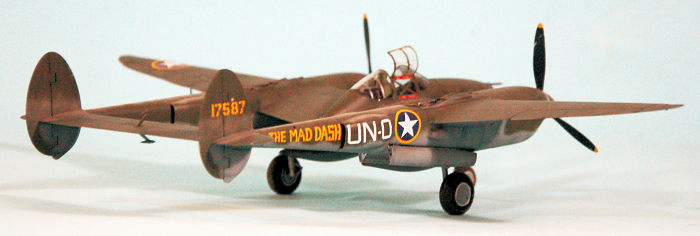 by the other
P-38s. When Ilfrey got home, the ground crew counted 268 bullet holes in the
P-38, including a 20mm shell that had smashed his radio and lodged in the seat
armor, while there was a cannon hit in one propeller blade of the “good” engine.
The P-38 was junked. A few days later, P-38F-1 41-7587 was flown in from the
depot in Morocco. Ilfrey named it “The Texas Terror” in honor of his home state,
with “The Mad Dash” on the other boom in memory of how he had come to own
41-7587.
by the other
P-38s. When Ilfrey got home, the ground crew counted 268 bullet holes in the
P-38, including a 20mm shell that had smashed his radio and lodged in the seat
armor, while there was a cannon hit in one propeller blade of the “good” engine.
The P-38 was junked. A few days later, P-38F-1 41-7587 was flown in from the
depot in Morocco. Ilfrey named it “The Texas Terror” in honor of his home state,
with “The Mad Dash” on the other boom in memory of how he had come to own
41-7587.
In mid-December, the group moved to Biskra airdrome, to begin escorting B-17s of the 97th Bomb Group. Missions were flown to Tunis, Bizerta, Sicily and Sardinia. On the third mission, Ilfrey spotted a damaged B-17 under attack from Fw-190s and took his flight of four down to protect the bomber. Ilfrey exploded his target, then he and Bob Neale got involved in a fight with two other 190s which they each shot down. As they turned to leave, they spotted two other P-38s in a fight with more 190s and turned into the enemy to help their friends escape. That night, their base was bombed by the Germans.
On December 26, 1942, Ilfrey led a flight on an escort mission to Bizerte. Over the target, he again spotted a damaged B-17 under attack by German fighters. He led his four down on the enemy and quickly shot down one Fw-190. Just as that plane went down, Ilfrey spotted tracers flash over his canopy. He managed to turn into the enemy by using his “combat flaps” and shot the attacker down. With that, Jack Ilfrey had a score of five and was the first P-38 ace of the war.
In May 1943, after flying 74 missions in 208 combat hours, Ilfrey finished his tour and returned to the United States, where he spent the next eight months instructing on P-38s before returning to combat in the spring of 1944 with the 20th Fighter Group in England.
Jack Ilfrey wrote his memoir, “Happy Jack’s Go-Buggy,” in 1946, when every minute of the previous five years was still fresh in his mind. The manuscript wasn’t published until 1979. It has a freshness and immediacy, being written when it was, that few other pilot memoirs possess. You can find used copies (as I did) at Amazon at attractive prices. It’s a memoir well worth adding to your library.
| THE KIT |
According to the tale my mother always told, I have apparently had a love affair with the P-38 since a very young age. According to the story, at age ten and a half months, I was in a park with her when a P-38 flew overhead, which I pointed at and screamed “O-pane! O-pane!” - my first intelligible word. I have liked the P-38 ever since. I first recall seeing one, which I later identified as an F-5G used for photo-mapping, during one of my visits to Stapleton Field with my father to watch airplanes - it was exciting at age 8 or so to see it land, then taxi over and shut down right on the other side of the fence from where we were. As a result, I think I have built every P-38 model ever released, starting with the old blue Aurora kit. My favorites have always been the early ones, due to their sharp look with their streamlined cowlings. I’ve managed to be around other P-38s in years since, and was privileged to know one of the very best P-38 pilots ever, Tony LeVier, over the last 20 years of his life. I’ve also known several others and collected their stories over the years.
Thus, when I learned this summer that Tamiya had announced they would release an early-model P-38F/G this fall, I was not one of those who lamented “Why can’t they do something else? We’ve already got the Hasegawa kits,” rather being one who said “Yes, but Hasegawa’s P-38s don’t put any money in Mr. Tamiya’s bank account.” As more details became known, it was obvious this was going to be something really special.
I t is. When one opens the box and sees the contents, everything exudes
quality. The other day, I saw a YouTube video in which a modeler completely
assembled the kit (other than the cockpit parts) without use of glue and had it
sitting on its gear. Yes, that’s how close the parts fit. In fact, the design of
this kit is such that anyone, from someone new to the hobby to someone with more
hours invested than even I have, who takes their time and follows the
instructions (they’re not “somebody’s opinion”), will have what each will call
“the best model in my collection!” The design of this kit is so modeler-friendly
that one would have to develop a detailed plan in advance in order to mess
things up. Parts fit in such a way that they ONLY fit where they’re supposed to
be, the way they’re supposed to be.
t is. When one opens the box and sees the contents, everything exudes
quality. The other day, I saw a YouTube video in which a modeler completely
assembled the kit (other than the cockpit parts) without use of glue and had it
sitting on its gear. Yes, that’s how close the parts fit. In fact, the design of
this kit is such that anyone, from someone new to the hobby to someone with more
hours invested than even I have, who takes their time and follows the
instructions (they’re not “somebody’s opinion”), will have what each will call
“the best model in my collection!” The design of this kit is so modeler-friendly
that one would have to develop a detailed plan in advance in order to mess
things up. Parts fit in such a way that they ONLY fit where they’re supposed to
be, the way they’re supposed to be.
The kit includes the differing clear parts for the P-38F and P-38G canopies, including both closed and open options, as well as other detail parts that differ between the two sub-types. Decals are included for the P-38F “White 33" from the 39th Fighter Squadron of the 35th Fighter Group in New Guinea in late 1942, and “Miss Virginia”, the P-38 flown by Rex Barber during Operation Vengeance, the mission to assassinate Admiral Yamamoto on April 18, 1943. (Several other historians I know have also noted that it’s strange Tamiya would include this option, while they refuse to produce an F6F Hellcat because “so many Japanese” were killed by Hellcats - life is strange.)
As an aside, for those modelers who have been residing on Mars for the past 20 years, there is no “controversy” over who shot down the admiral. In 2006, Thomas Lanphier’s long-suspect claim was conclusively determined, by exhaustive technical research and extensive interviews with surviving Japanese pilots, to be impossible; the Air Force now officially recognizes Rex Barber as the successful pilot. This event proves one should always be careful when assigning someone to write up the mission report.
One other thing becomes apparent looking at the parts: Tamiya plans other versions, and not just a J/L. The central nacelle nose has a “dip” in it, just where the cameras would be located in an F-4 or F-5 photo plane, and with the separate nose bay doors (which are on a sprue with other parts that would change with a different version), it would be no problem to produce these with the camera windows; this can be coupled with the fact the lower half of the central nacelle is on its own sprue, which means a different part could be subsituted with the lower windows. The separate nose cap means they could go so far as to do a “droop snoot.” The fact the upper-forward section of the outer wings are separate parts, means they can do that section as the extra gas tank it was on the later airplanes, while the separate lower outer wing part (on a separate sprue) means they can produce the wing with the dive flap. Tamiya also mentions specific additional sub-types of P-38 in the history section of their instructions. It’s almost always a fool’s errand to try and predict anything with Tamiya, but the fact they never mention other sub-types in other kits that don’t get released as separate models can be taken as “tea leaves.” The modular parts production on their F4U-1 series of Corsairs resulted in kits that used these different parts.
| CONSTRUCTION |
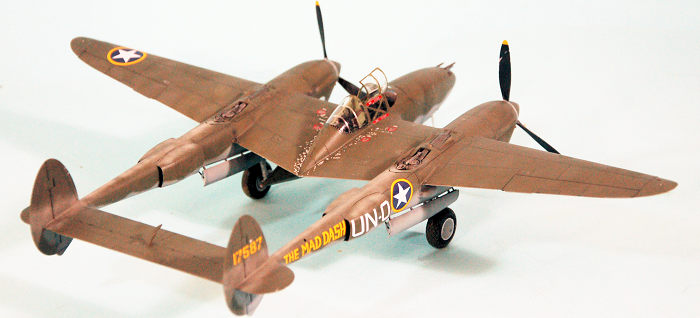 This kit is complex, but it is not complicated. It is the most
“modeler-friendly” kit design I have encountered in any model I have ever built.
Every part fits very exactly, exactly where and how it should, and it is
impossible to fit the wrong part in the wrong place unless one is paying no
attention at all to the instructions. These instructions are not “someone’s
opinion,” and you really should follow them. The only “difficulty” I encountered
is that - counter-intuitively - “Option A” refers to the P-38G, while “Option B”
refers to the P-38F. I can only surmise that these designations came from the
expectation that the majority of those who buy the kit will do Barber’s
airplane.
This kit is complex, but it is not complicated. It is the most
“modeler-friendly” kit design I have encountered in any model I have ever built.
Every part fits very exactly, exactly where and how it should, and it is
impossible to fit the wrong part in the wrong place unless one is paying no
attention at all to the instructions. These instructions are not “someone’s
opinion,” and you really should follow them. The only “difficulty” I encountered
is that - counter-intuitively - “Option A” refers to the P-38G, while “Option B”
refers to the P-38F. I can only surmise that these designations came from the
expectation that the majority of those who buy the kit will do Barber’s
airplane.
As with any CAD-designed kit, you must be absolutely certain to trim away every tiniest bit of sprue nib residue on the parts, and it’s a good idea not to paint the surfaces of the parts to be glued together. The parts fit is that precise and tight.
My only deviation from the assembly sequence was to perform the assembly of the cockpit in one process, combining the first part of the assembly at the outset with the second part of assembly shown at close to the end, because I wanted to get all those parts into the cockpit and under the protection of the canopy parts early on, in the expectation that otherwise something irreplaceable might get knocked off. I also cut away the sun shade, because it was not used that frequently; as Steve Hinton, the highest-time P-38 pilot in the world, pointed out to me, it’s a lot easier to glance at the instruments if you don’t have to lean over to look under the shade. Doing this also opens up more of the nicely-detailed cockpit to be seen once the model is finished. The fact it’s provided as a separate part makes this bit of surgery very easy.
At this point, it’s advisable to talk about the actual colors used on early P-38s, since that will affect what you do in assembling the cockpit.
It’s amazing how little, it turns out, is actually known about early P-38s. Perhaps it’s the fact there were none to examine until “Glacier Girl” was retrieved from the Greenland ice cap where she lay for 65 years and restored. Those restorers put every effort into recreating the airplane in original condition, copying exactly all paint colors encountered in the process.
 I first became aware of what this might mean back in 2007, when the
airplane spent a long visit at Planes of Fame. I had a good opportunity one
Saturday when there weren’t many visitors, to get “up close and personal” with
her. The first thing I noticed was that the camouflage colors weren’t Olive Drab
and Neutral Grey, as “everyone knows” P-38s were painted. I concluded the upper
color was probably “green base” pre-war OD 41, but wasn’t sure about what to
call the lower color, which is a close but lighter shade of grey than
traditional Neutral Grey. I also had the chance to sit in her cockpit, where it
was very noticeable that it was not painted in any shade of Interior Green I had
ever run across, even taking into account that “Interior Green” differed from
manufacturer to manufacturer, and could vary according to who mixed that batch.
Glacier Girl’s cockpit is a light grey-green that looked like nothing so much as
British Interior Green.
I first became aware of what this might mean back in 2007, when the
airplane spent a long visit at Planes of Fame. I had a good opportunity one
Saturday when there weren’t many visitors, to get “up close and personal” with
her. The first thing I noticed was that the camouflage colors weren’t Olive Drab
and Neutral Grey, as “everyone knows” P-38s were painted. I concluded the upper
color was probably “green base” pre-war OD 41, but wasn’t sure about what to
call the lower color, which is a close but lighter shade of grey than
traditional Neutral Grey. I also had the chance to sit in her cockpit, where it
was very noticeable that it was not painted in any shade of Interior Green I had
ever run across, even taking into account that “Interior Green” differed from
manufacturer to manufacturer, and could vary according to who mixed that batch.
Glacier Girl’s cockpit is a light grey-green that looked like nothing so much as
British Interior Green.
 Sometime later, when I was over at “T(for Tony) & A(for his mother,
Addie) Hobby Shop” in Burbank, I thought to ask Addie if she might know about
this, since I knew she had worked in the paint shop at Lockheed at one time
before going to work in the model-making department. When I told her what I had
seen, she told me that back then, “the only paint we had was the paints they’d
ordered for the Hudsons.” I knew that Lockheed, which had been making Hudsons
for the RAF before Lend-Lease, had (as had Grumman with their Martlets) procured
paints mixed to the RAF specifications. Going on Addie’s comment, it was very
likely that Lockheed had used the RAF paints on their first P-38s. This was
reinforced in 2016, when I interviewed George Underwood for my book “The
Bridgebusters.” George mentioned he had graduated from Hollywood High mid-year
in February 1942, and gone to work at Lockheed while he waited to turn 18 and
join up. It turned out he had worked in several shops, including the paint shop.
His strongest memory of the time was that “Everything was in short supply and we
used what we had.” Paint usage probably wasn’t something covered in a yet-to-be
discovered memo in the Lockheed archives, but this anecdotal evidence makes such
an explanation as I present here logical.
Sometime later, when I was over at “T(for Tony) & A(for his mother,
Addie) Hobby Shop” in Burbank, I thought to ask Addie if she might know about
this, since I knew she had worked in the paint shop at Lockheed at one time
before going to work in the model-making department. When I told her what I had
seen, she told me that back then, “the only paint we had was the paints they’d
ordered for the Hudsons.” I knew that Lockheed, which had been making Hudsons
for the RAF before Lend-Lease, had (as had Grumman with their Martlets) procured
paints mixed to the RAF specifications. Going on Addie’s comment, it was very
likely that Lockheed had used the RAF paints on their first P-38s. This was
reinforced in 2016, when I interviewed George Underwood for my book “The
Bridgebusters.” George mentioned he had graduated from Hollywood High mid-year
in February 1942, and gone to work at Lockheed while he waited to turn 18 and
join up. It turned out he had worked in several shops, including the paint shop.
His strongest memory of the time was that “Everything was in short supply and we
used what we had.” Paint usage probably wasn’t something covered in a yet-to-be
discovered memo in the Lockheed archives, but this anecdotal evidence makes such
an explanation as I present here logical.
I’m including with this review a color shot of “Glacier Girl’s” cockpit taken in daylight, which clearly shows the light grey-green color, which I believe is British Interior Green. I’m also including some photos I took of Glacier Girl (unfortunately, that day I got to be “up close and personal” with her was one in which I expected to do other things and didn’t bring a camera with me, so these are air show shots) in daylight, which I think can be identified as “RAF Dark Green” for the upper color and what was called back then “Sky Grey,” the color mistakenly used by US aircraft manufacturers in place of RAF “Sky,” which is also a very close match to RAF “Sea Grey Medium,” for the lower color.
One reason why no one may have ever taken note of early P-38s being painted in unexpected colors is the fact that “RAF Dark Green” and pre-war US “OD-41" are essentially the same color. They were mixed to the specifications of World War I British “P.C. 10", the camouflage color used on RFC and RAF aircraft (which back then hardly ever looked like the original specification, since every manufacturer who made the stuff did their own take on it). So, in 1941-43, anyone looking at a P-38 would see a color they knew as “Olive Drab”, and likely never thought further about the grey. (It’s really a shame that IPMS Switzerland was unable to place Colourpolizei in every aircraft factory to insure everyone was using “proper” paints.)
I’ll also note that Tamiya did their research, and when you look at the nice full-color painting instruction sheet, you’ll see the airframe is in these colors, albeit not with their British names. They obviously paid attention to “Glacier Girl,” which is the airplane I’m willing to bet they based their research on.
Thus, I used Tamiya XF-71 “Cockpit Green,” which is really “Mitsubishi
interior green,” which was based on British Interior Green, for the cockpit. If
you’re one of those who considers “proper colors” important, you should too. You
could also use Xtracolour/Xtracrylix “British Interior Green.” Some researchers
have said that early P-38 cockpits were painted “Olive Drab.” If so, it almost
certainly would have been the “RAF Dark Green” color, probably done on an ad hoc
basis when supplies of the British Interior Green color ran short (“Ever ything
was in short supply and we used what we had.”). If you have photos of the
cockpit of the plane you’re doing that show it a dark shade in black and white,
that’s a likely explanation.
ything
was in short supply and we used what we had.”). If you have photos of the
cockpit of the plane you’re doing that show it a dark shade in black and white,
that’s a likely explanation.
Past that, I followed the kit painting instructions for the cockpit. In assembly, my recommendation is that when you attach the armor glass to the windscreen, you use something like Micro “Krystal Klear” or other white glue that dries invisible without harming the clear parts, because it is impossible to get just a little bit of CA or other glue onto those attachment points and then attach the part without the possibility of smearing things.
The provision of steel balls for weights is really ingenious, and the manner in which the cockpit tub is attached to the upper part of the central nacelle is guaranteed to get everything located precisely where it should be. The provision of the wing spar that also has the attachment for the weight in the nose insures that the alignment of this sub-assembly will be completely problem-free.
The booms are similarly precise in design. Unlike the Hasegawa kit, where the different radiator intakes do not attach on a panel line, and thus have to be puttied and sanded smooth with the panel lines rescribed, every separate part on these booms - which are separate because they will be replaced in different subsequent releases - are attached on a panel line.
The wheel wells are far more detailed even than the 1/32 Trumpeter kit I built, and far moreso than the Hasegawa kits, without being complicated to assemble. The method of attaching the gear doors is another ingenious little detail, in which it is impossible to get the wrong door on the wrong side, with a strong attachment that completely solves the problem of the most annoying part of assembling a Hasegawa kit.
The booms attach to the wing/center nacelle sub assembly by “clicking” (listen for it) into place. The piece de resistance is the one-piece horizontal stabilizer that slides into position in such a way that it guarantees alignment between the two booms (something you have to fiddle with when assembling a Hasegawa P-38).
I painted the wheel wells, landing gear and gear door interiors with Vallejo White Aluminum, to represent the aluminum lacquer they were painted (on both the F and the G sub-types) and assembled everything, painted, before painting the exterior of the model. This is easy to do - stuff some tissue inside the wheel wells and you’re covered.
Armed with the photo I have (shown here) of “Texas Terror,” which shows it had a UHF radio mast under the nose (which isn’t provided in the kit), I used one of the unused antenna masts from an Eduard P-51 kit.
| COLORS & MARKINGS |
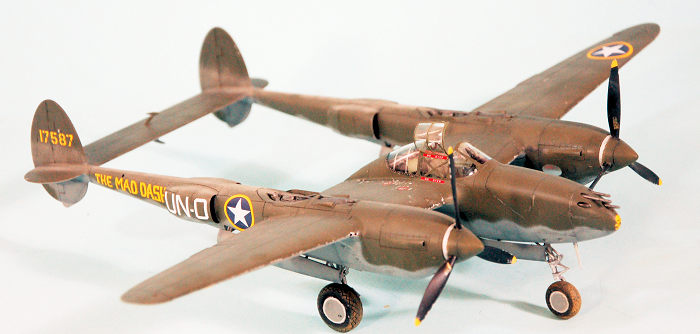 When researching the paint scheme for “Texas Terror” I saw that other
modelers have done the ring at the rear of the prop spinners in yellow. The Kits
World Decals showed this as being silver, and this conclusion was reinforced by
looking at the photo of “Texas Terror” where the spinner ring can be seen and it
is the same shade as the UHF antenna, which was likely unpainted aluminum. On
the basis of that educated guess, I painted that area of the spinners with
Tamiya “Flat Aluminum,” then masked it off.
When researching the paint scheme for “Texas Terror” I saw that other
modelers have done the ring at the rear of the prop spinners in yellow. The Kits
World Decals showed this as being silver, and this conclusion was reinforced by
looking at the photo of “Texas Terror” where the spinner ring can be seen and it
is the same shade as the UHF antenna, which was likely unpainted aluminum. On
the basis of that educated guess, I painted that area of the spinners with
Tamiya “Flat Aluminum,” then masked it off.
I applied pre-shading with Tamiya “Semi-gloss Black”, then painted the lower surface with Tamiya XF-83 “Sea Grey Medium,” thinned 50-50. I painted the upper surface with Tamiya XF-81 “RAF Dark Green.” Since I knew Ilfrey had only had the airplane for about 7-10 days by the time he scored his fifth victory, and that winter in North Africa doesn’t include a lot of sun peeking through the rain clouds to fade the paint, I only went back over the upper surface with the XF-81 lightened with a couple brushfulls of XF-55 “Deck Tan”, thinned with 60% alcohol, to change the shade here and there a bit.
I used the Kits World Decals for the individual markings and for the national insignia, and the kit decals for the stenciling. No problems were encountered and they went down under a coat of Micro-Sol.
I gave the model an overall coat of Tamiya “Clear Flat.” I then unmasked the canopy. The exhaust stains on the booms were done with thinned “Deck Tan.” I “muddied up” the wheels since Ilfrey in his book goes out of his way to mention what a “sea of mud” they were dealing with at the time. I gave some minor “dings” to the airframe and called it finished.
| CONCLUSIONS |
If you like the P-38, you will love this kit. Anyone from a newbie to a long-time veteran can get a really excellent result from the model if they follow the instructions. Without a doubt, this is one of Tamiya’s best kits ever, and it establishes a new, higher bar for “modeler-friendly kit design.” It’s expensive, even if you find an “internet bargain,” but as they say in my other job, “every penny is up on the screen.” And no, it doesn’t make your Hasegawa kits “obsolete” - the difference between the two is in the building. Completed, they are both quite compatible with each other.
The kit presents great value. Highly recommended for everyone.
31 October 2019
Copyright ModelingMadness.com.
Review kit courtesy of my wallet.
If you would like your product reviewed fairly and fairly quickly, please contact the editor or see other details in the Note to Contributors.
Back to the Main Page Back to the Review Index Page Back to the Previews Index Page